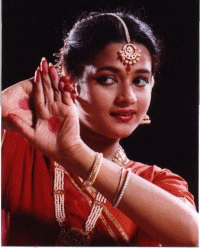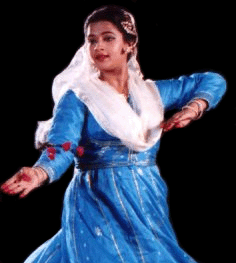Dec 12, 2025
Dec 12, 2025
by Rani Khanam
 In this article, I have tried to bring into focus the two fascinating aspects of Kathak which are becoming rare day by day. Efforts put into improving and highlighting these two aspects of Kathak, include detailed and minute study of those factors and the lack of various elements leading to the downfall of this dance form and also loosing the regality associated with it. For what reasons these forms could not be maintained in the original styles? How it all lead to the downfall of these forms?
In this article, I have tried to bring into focus the two fascinating aspects of Kathak which are becoming rare day by day. Efforts put into improving and highlighting these two aspects of Kathak, include detailed and minute study of those factors and the lack of various elements leading to the downfall of this dance form and also loosing the regality associated with it. For what reasons these forms could not be maintained in the original styles? How it all lead to the downfall of these forms?
For this I have minutely and intensely studied a number of personalities who have witnessed the old style of this dance form in its original self and have also observed the process of it undergoing change. The studies include interviewing these artists who learnt Bhav Batana and have been performing it till date and also who have left it behind.
Katha-Vaachan has not changed greatly because the Nritya Paksha of traditional Kathak has not changed much from medieval period till date. Evidences suggest that during the fifth and sixth century in Mathura and its surrounding areas, there used to be performances in the form of plays based on Krishna narrating Krishna Katha in the form of another dance form known as Raaslila. These plays aimed at narrating the story and life of Krishna to common people.
These story tellers used to study in detail about the life and various incidents and experiences connected with Krishna and by using their imagination they would portray these incidents with telling impact on the audience. This kind of narration took place outside the temples and the Kathavachak would sing the stories based on Krishna with expressions. They would use short pieces of dance primarily to connect two stories or incidents. When this form of Katha-Vaachan entered the palaces, the kings used it for the sake of entertainment with extra emphasis on the dance portion instead of the Krishna Katha. This is where the Nritya Paksha of Kathak dance form became strong and got divided into two parts: a) The narration of story and b) Kathak as a form of performing art or as the mono dance theatre.
Initially, Kathavachak was very popular and the people (audience) would sit for the whole night, never minding even paying for the sake of entertainment. Earning from these performances in the days gone by was good. Now with the massive influence of films and the impact of electronic media like radio and television, theKathavachak is not in demand even in the rural areas. Besides the present dayKathavachak is not imaginative enough to make Katha-Vaachan an interesting affair. They obviously cannot compete with the celluloid.
There is, however, scope for improvement. This can be achieved by bringing by embedding with the art of story telling the technical elements of Gat-Nikas, Gat-Bhav and Chaal and also Tihai, Tukra, Paran etc. An effective use of Dupattacan also provide an expressive dimension leaving an impact on the audience. Lastly, the most important skill of a Kathavachak is to have good singing quality as most of the Kathas are originally in verse form.
Bhav Batana
 Dramatization or Bhav Batana is purely based on expression. Abhinaya or the art of expressive acting is a key ingredient of drama. The last Mughal emperor Mohammed Shah (popularly known as Rangila Piya) was all for dance and music, but it was during the reign of Wajid Ali Shah that the art in general and music and dancing in particular flourished in an unprecedented manner. Hakim Md. Imam has written in Madaran Mausaki, Nawab Wajid Ali Shah's great patronage to this art giving opportunity to a large number of artists. DescribingBhav Batana, he writes "...in fact Benares is a center where a style of singing, dancing and Bhav Batana flourishes, a style most favored by the present generation." In Sangeet Kaladhar (18th century) written by a state musician of Bhavnagar, explains the several aspects of Bhav.
Dramatization or Bhav Batana is purely based on expression. Abhinaya or the art of expressive acting is a key ingredient of drama. The last Mughal emperor Mohammed Shah (popularly known as Rangila Piya) was all for dance and music, but it was during the reign of Wajid Ali Shah that the art in general and music and dancing in particular flourished in an unprecedented manner. Hakim Md. Imam has written in Madaran Mausaki, Nawab Wajid Ali Shah's great patronage to this art giving opportunity to a large number of artists. DescribingBhav Batana, he writes "...in fact Benares is a center where a style of singing, dancing and Bhav Batana flourishes, a style most favored by the present generation." In Sangeet Kaladhar (18th century) written by a state musician of Bhavnagar, explains the several aspects of Bhav.
This shows how flourishing the Bhav was in the Royal courts of medieval period. Laluji and Prakash Kathak were Ustads of Lucknow, Beni Prasad and Prasadoo Kathak of Benares also talented Ustads were known in that time for proficiency in dancing and Bhav. Bindadin Maharaj, gifted with poetic learning and a great composer, was famous for Bhav Batana in sitting posture. In recent memory, the most experienced was Shambhu Maharaj known for Sanchari Bhav and hailed as a superb exponent of Abhinaya with spontaneity and excellence.
Today while some of the contemporary artists have managed to keep this legacy alive, both their reach and approach remains limited. One of the reasons being that earlier this art form would take place in a Darbar or a Mehfil whereas now the theatre is highly commercialized and the gap between the audience and stage is vast to truly appreciate the dance form of Bhav which is expressed by eyes.
The ideal situation would be a Mehfil type compact area and a good vocalist-dancer to perform this style. As Jiwan Pani states, "Shambhu Maharaj used to sing Thumrifirst, then expressed with Abhinaya. He took one line of a song and creatively interpreted it in several ways while sitting on the stage. He would sing the same line with different tones of emotion which was a distinct style of his own." In the famous Thumri 'Kaun Gali Gaye Shyam' to give a myriad look to the Gali, he would express by depicting lines on his palm or parting of the hair or applyingsurma to the eyes, thus revealing the deep relationship between singing andAbhinaya.
Similarly, my Guru Pt. Birju Maharaj in his famous Thumri, 'Balma Re Chunariya Lal Rang De', he would go beyond imagination to describe the nature of Lal (Red) in a wider spectrum. It is with him that I learnt about this dance form requiring a strong power of imagination and a clearer understanding about literature, be it the Epics or a character to be performed, for it is only then that an innovative touch can be given by the artist to make the performance appealing and interesting.
Rani Khanam is one of the foremost Kathak exponents of India, equally consummate in her mastery over the rhythm, grace and expressional cogency. She first learnt under the tutelage of Smt. Reba Vidyarthi and later under guru Pt. Birju Maharaj for more than a decade. She specialized in the Lucknow style of Kathak graduating with top honors from the prestigious National Institute, The Kathak Kendra, New Delhi. Currently she is a Director at Aamad, The Academy of Performing Arts, New Delhi for propagation of Kathak. With exceptional prowess in rhythm and the aesthetics of expression, the themes of her performances reflect transcendental and abstract thoughts, portraying a sensitivity to the need for creative expression.
25-Mar-2001
More by : Rani Khanam